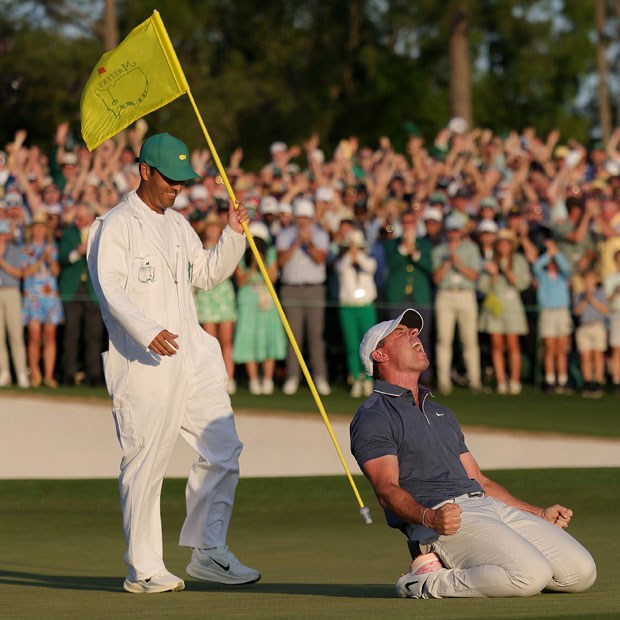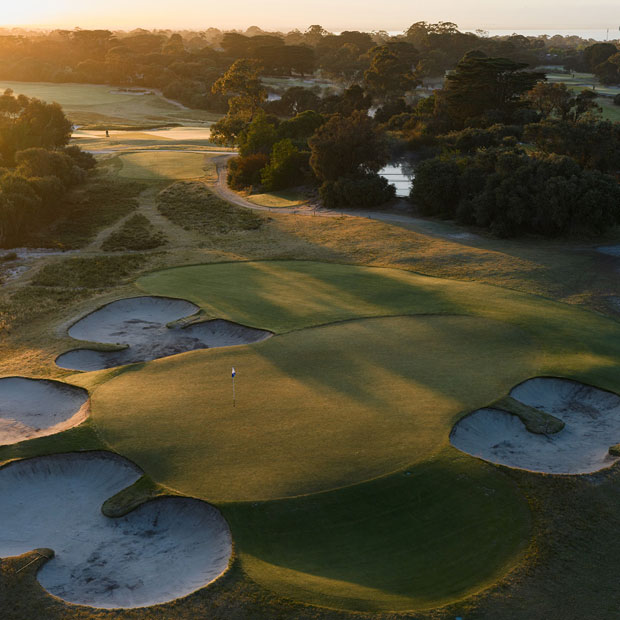The History of Royal Troon’s Postage Stamp
Royal Troon's most famous hole wasn't originally part of the course


The short par 3 has enjoyed some coverage around the internet in recent months, with precisely zero articles suggesting there are too many of them. Indeed, who among us doesn’t look forward to playing a hole measuring between 100 and 130 yards? The 109-yard seventh at Pebble Beach is surely the best-known; others include the 13th at Merion, 12th at Shoreacres, and the seventh at Barnbougle Dunes. But this week they all yield to the eighth at Royal Troon, venue for the 152nd Open Championship.
Otherwise known as the “Postage Stamp,” the hole measures 123 yards from the Open tees (but can, and has, played to 99 yards) and, like the other superlative mini-3s, is an easy sand wedge that can nevertheless turn very ugly very quickly if so much as a breath of wind throws the ball offline. You’ll find plenty of websites that assume the hole dates back to 1878 as part of the club’s original layout, but it actually didn’t appear for another 30 years or so.
It’s not clear exactly how many holes were in play when Troon opened, but it wasn’t many. Most sources say there were six, many say five. Even the club’s official history, 2001’s The Breezy Links of Troon by R.A. Crampsey, isn’t entirely sure. What is certain, though, is that the Postage Stamp wasn’t one of them.

It didn’t arrive until Willie Fernie replaced original club pro George Strath. Fernie’s hiring, in 1888, was a big deal for Troon, as the St. Andrews native had won the Open Championship in 1883 at Musselburgh (he would also finish second four times). He began updating the course around 1908 or 1909, combining the “Ailsa” and Turnberry” holes to form the par-5 sixth, and the “Garden” and “Well” holes on the back nine to create the par-5 16th. That meant he had to find two new holes, and the two he found were pearls that have become by far the course’s most famous, even though one is drastically different today.
The new eighth was a short hole he called “Ails,a” replacing the lost “Ailsa” and named after the huge granite rock 20 miles to the southwest in the Firth of Clyde. It’s rumored that the green first sat beyond the huge sand hill to the left of the current green, calling for a similarly lofted shot as required at the original Maiden hole at Royal St. George’s. Evidence, though, is scant.
The hole was rendered by the great Harry Rountree, whose painting appeared in Bernard Darwin’s The Golf Courses of the British Isles, published in 1910. It showed a flattish putting surface wrapping around the colossal dune, with no bunkers left of the green. To the right, there appears to be a couple of formal bunkers and exposed sand scrapes.
In his book, all Darwin said of it was that it was “one of the finest short holes to be found anywhere.” Five-time Open champion James Braid (who had just won his fifth Claret Jug, at St. Andrews) played the new course alongside fellow Great Triumvirate members Harry Vardon and J.H. Taylor, writing that Troon’s eighth was “all that a short hole should be—it is very difficult and demands the tee shot be a perfect one.” Perhaps not surprisingly, many of the members considered it too difficult, and in an effort to reduce its severity often used the dune as a backboard, banking balls off the slope and having them trundle down onto the green.
{{content-block-royal-troon-postage-stamp-001}}
Fernie’s other great addition to the course was a new 11th. Previously, after completing the 10th, golfers would head west and play a 327-yard hole to the Fox green (today’s 12th), but Fernie added a 315-yard hole, “Railway,” that played in a northeasterly direction from a tee far to the left of the 10th green to a new green close to the tracks. A large bunker sat in front of the tee, prompting Fernie to write, “The Railway is also a dangerous hole, the chief difficulty being the tee shot which has to be picked up fairly quickly to avoid a very nasty, high, sand face.”

In 1922, Troon was surprisingly awarded the following year’s Open Championship, as Harry Colt was busy redesigning Muirfield, which had been expected to host its sixth Open. Braid, a good friend of Fernie’s, was called upon to carry out swift changes in order to make the course championship-worthy. The Scot added 67 bunkers, including a couple of card-wreckers at the eighth, where he carved a huge pit into the face of the dune to prevent the rebound shot. He added another at the base of the dune, with a significant lip.
As can be seen elsewhere on the course and, indeed, throughout the 400+ other layouts he worked on, Braid was a strategist who dismissed overly penal holes. Among his design principles, published in Advanced Golf in 1908, he stated there should “as frequently as possible be two alternative methods of playing a hole, an easy one and a difficult one, and there should be a chance of gaining a stroke if the latter is chosen and the attempt is successful.” He also said that every green should be “well-guarded,” and that the “shorter the hole the smaller should be the putting green, and the more closely should it be guarded.”
Fernie was enamored of Braid’s changes at the eighth, saying, “There is now only one course open to the player, to pitch his ball on the green and make it stay there, no easy feat with even a little wind.” He had no doubt many would make a two, but suspected just as many would make six. “As an instance of this,” he added, “in one competition, the lowest figure was one and the highest twelve.” (German amateur Herman Tissies would have welcomed a 12 after making a 15 at Postage Stamp during the 1950 Open.)
As Rountree’s painting shows, the green was always small (barely 3,500 square feet), and it seems members took to calling it “Postage Stamp.” In the weeks before the championship, much of the press noted that members referred to the hole as the Postage Stamp, and the name began to stick. It is, however, forever linked with two-time Open champion, Willie Park Jr., who used the term in a pre-1923 Open article in Golf Illustrated. Fernie made no mention of Park’s comment in a booklet he wrote prior to the Open that described the course, though he did write “This hole has frequently been described as the ‘Postage Stamp,’ the ‘Pocket Handkerchief,’ and many other names quite unprintable.” That suggests Fernie had written his booklet before Park’s article was published.

By the 1950 championship, the bunkers around the eighth green had shrunk significantly, yet were terrifyingly deep. Thanks to a temporary rule change penalizing golfers distance-only when faced by a shot they regarded as unplayable, when Argentinian Roberto De Vicenzo found the sand, he decided to return to the tee. From there he hit the green with his second shot, holing the putt for par.
It took a while for Fernie and Braid’s eighth to become popular with the members, and though the vast majority of professionals always seemed to regard it highly, there was one who didn’t much care for it. Australia’s Peter Thomson won five Open Championships, with his victories coming at St. Andrews, Royal Lytham and St. Annes, Hoylake, and Royal Birkdale (twice). He managed a T-6 and T-31 in his appearances at Troon, and said of the Postage Stamp in 1973, “If I built a hole like that as a course architect, I’d expect the client to ask for his money back.”
As for the new 11th, it played at 326 yards in 1950. A new green was then built before the 1962 Open, some 150 yards farther along the tracks. Moving the tee to a spot between the 10th green and the railway created a 485-yard par 5, which Arnold Palmer (winner that year by six shots) called “fearsome.” Jack Nicklaus carded a 10 in round one that year. Playing as a 482-yard par 4 in 2016, No. 11 was the toughest hole in three of the four rounds, playing to a stroke average of 4.55 for the week. It is now a 498-yard par 4, and if the wind comes out of the north as expected, it will very likely be the hardest hole on the course.
There’s so much more to Royal Troon than the eighth and 11th, but if you’re looking for drama this week, look to the two latecomers.
{{content-block-royal-troon-postage-stamp-002}}
Related content:
– Architect Jaeger Kovich on the Postage Stamp at Royal Troon
– The Fried Egg Golf Podcast: Previewing Royal Troon
For more coverage of the Open Championship, visit the Fried Egg Golf Open Championship hub here.
Leave a comment or start a discussion
Engage in our content with thousands of other Fried Egg Golf Club Members
Engage in our content with thousands of other Fried Egg Golf Members
Get full access to exclusive benefits from Fried Egg Golf
- Member-only content
- Community discussions forums
- Member-only experiences and early access to events












Leave a comment or start a discussion
Lorem ipsum dolor sit amet, consectetur adipiscing elit. Suspendisse varius enim in eros elementum tristique. Duis cursus, mi quis viverra ornare, eros dolor interdum nulla, ut commodo diam libero vitae erat. Aenean faucibus nibh et justo cursus id rutrum lorem imperdiet. Nunc ut sem vitae risus tristique posuere. uis cursus, mi quis viverra ornare, eros dolor interdum nulla, ut commodo diam libero vitae erat. Aenean faucibus nibh et justo cursus id rutrum lorem imperdiet. Nunc ut sem vitae risus tristique posuere.